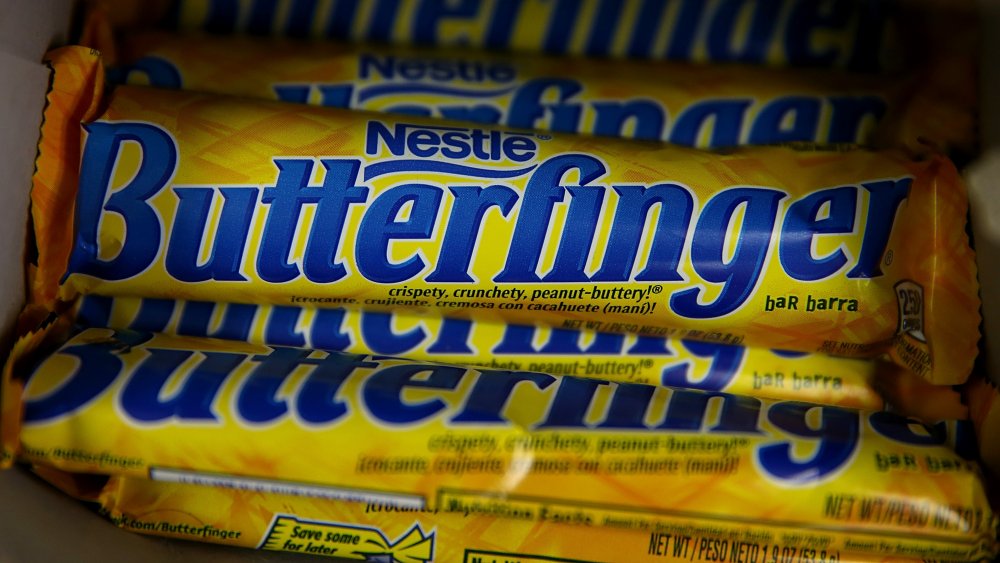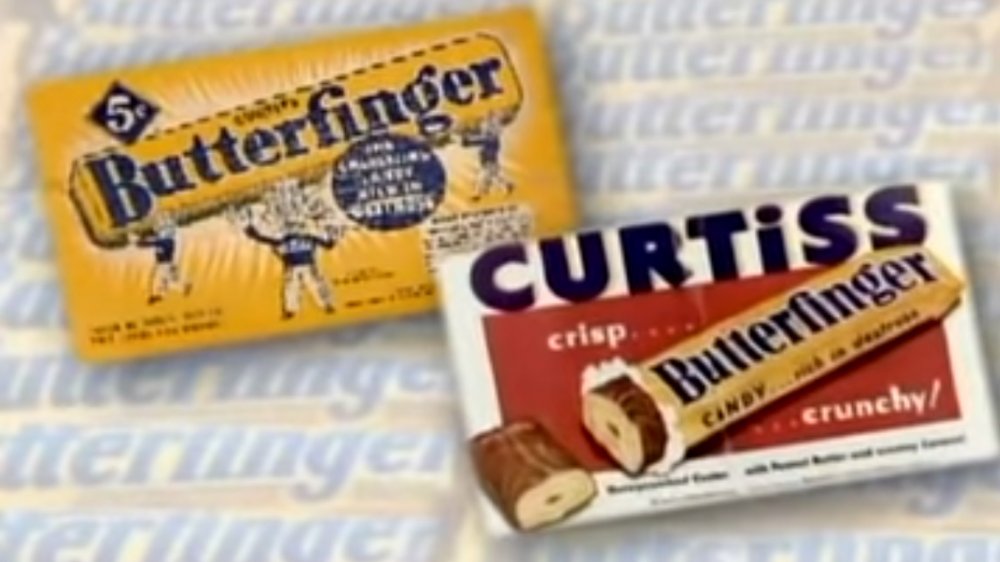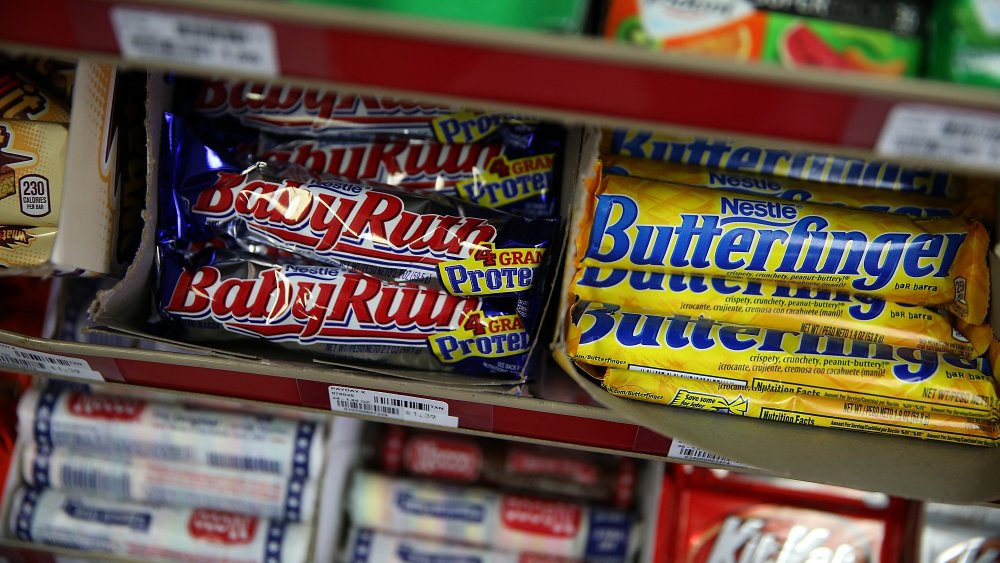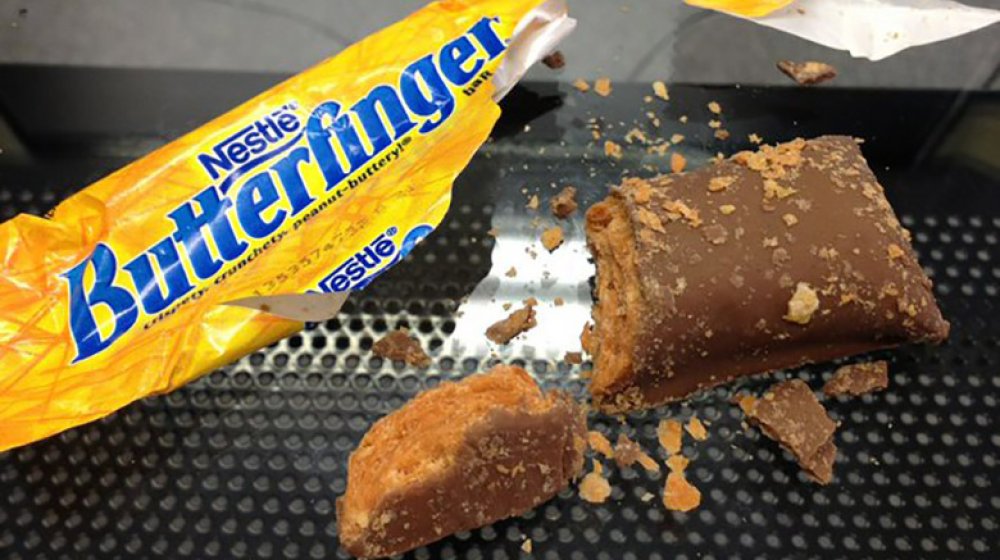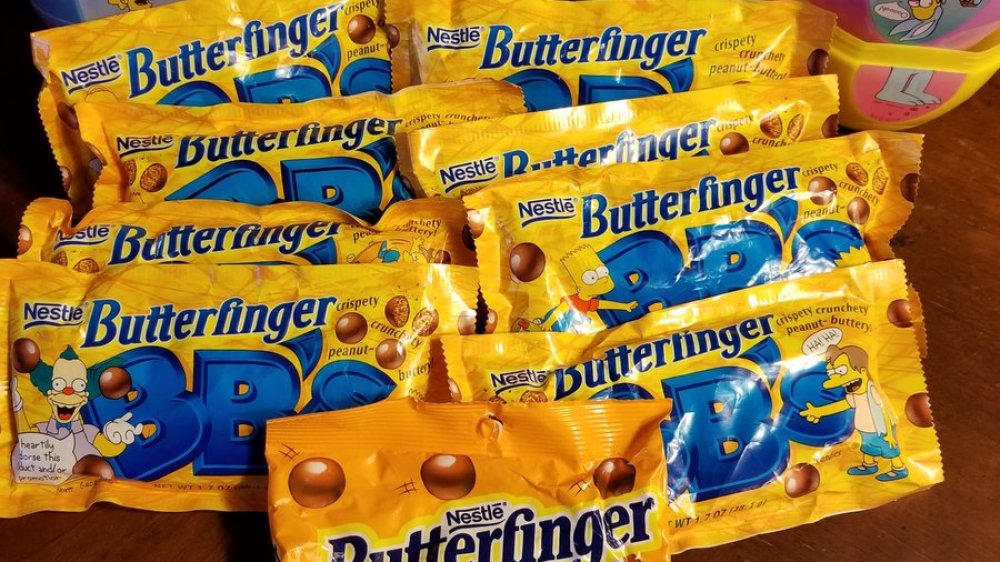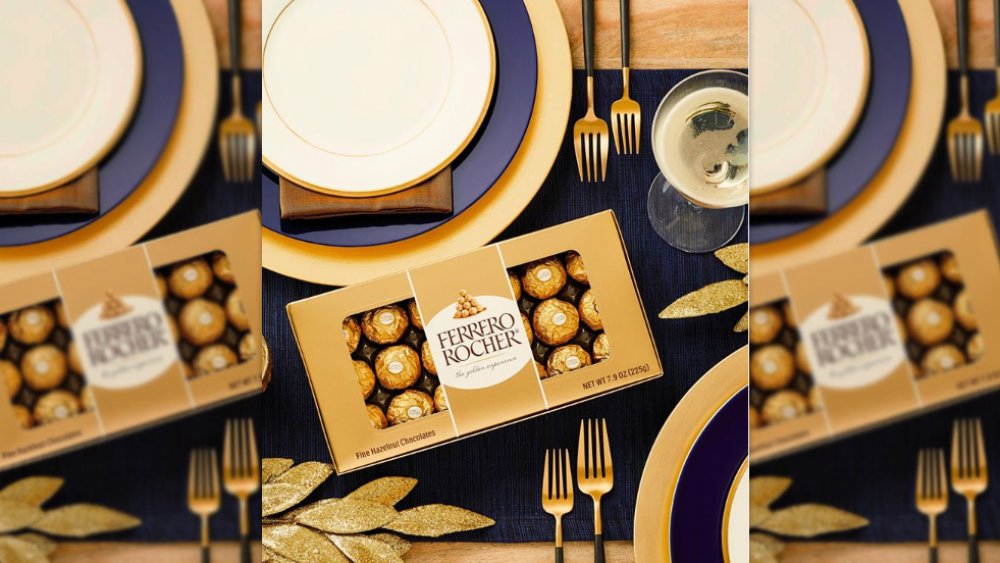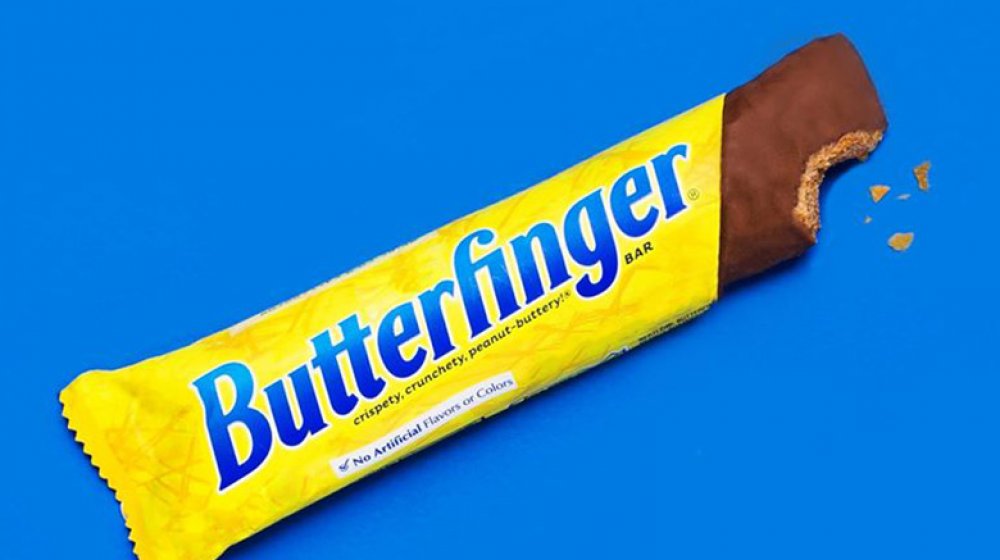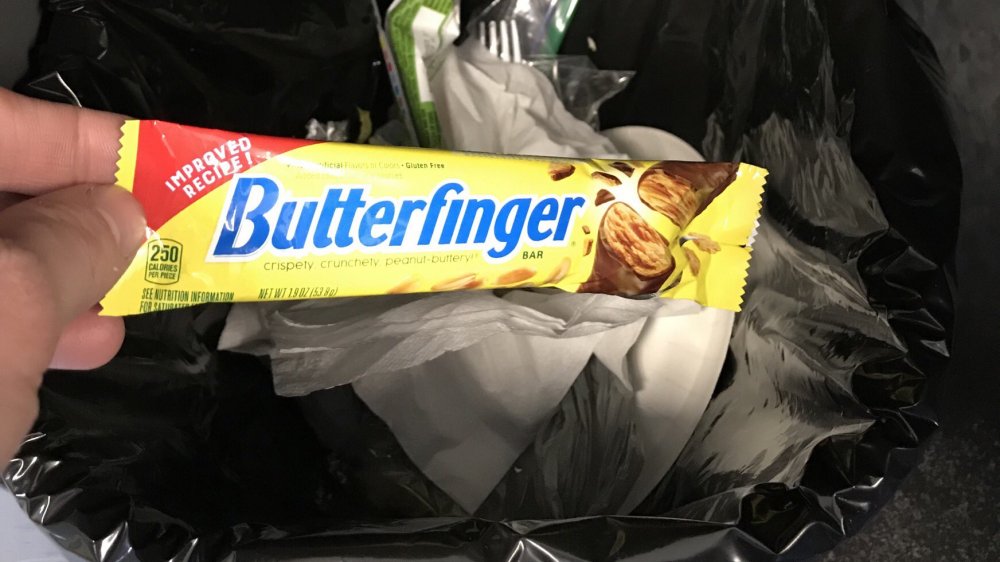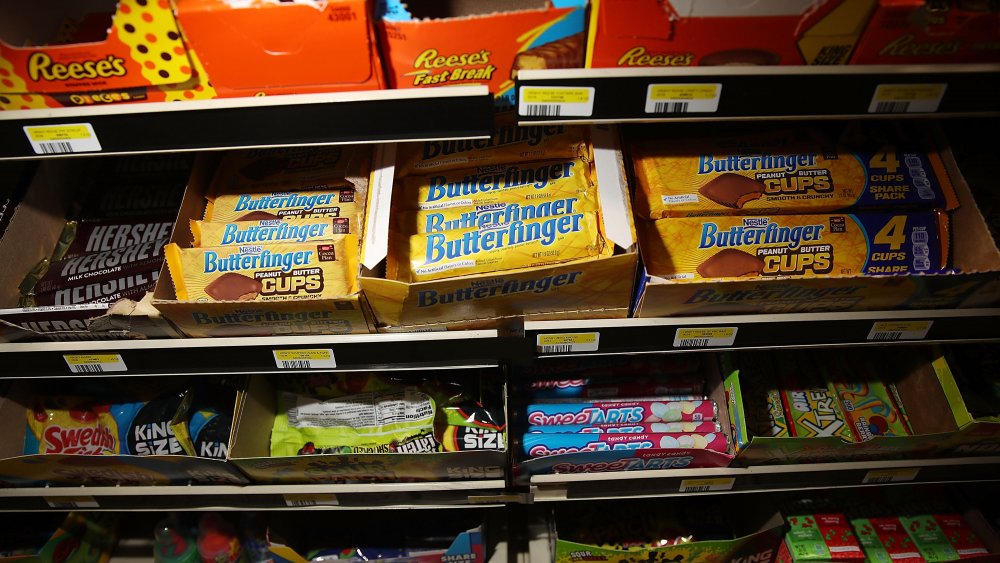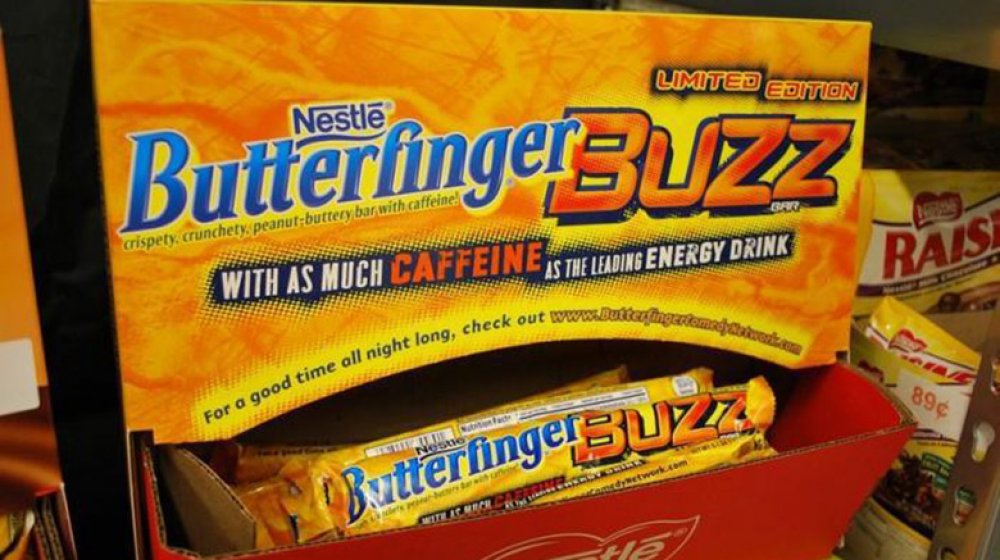The Untold Truth Of Butterfinger
It's "crispety." It's "crunchety." It's full of chocolate and peanut-buttery goodness that sticks to your molars like super glue — it's Butterfinger. There are certain candy bars that just about everyone can say they've tried at least once in their life and Butterfinger is certainly one of those candy bars.
It's bright orange, flaky candy center may not be for everyone — and is probably despised by most dentists — but it's a staple American candy bar. Candy bars come and go and Butterfinger has proven itself to be a candy survivor that has spanned generations.
The candy bar isn't far off from its 100th birthday and in its near-century of existence, Butterfinger has weathered its share of ups and downs. The candy bar has been dropped from planes, kicked out of German supermarkets, and most recently, had its recipe called into question (via Business Insider).
It's time to ignore Bart Simpson's warning and lay a finger on the candy bar in the bright yellow wrapper known as Butterfinger.
Butterfinger got its name from a contest
If there was one city in the United States that could be called the "candy capital" it would be Chicago. Sorry, Hershey, Pennsylvania. Iconic candies ranging from Milky Way to Oh Henry!, and Wrigley gum can trace their roots to Chicago, and the same can be said for Butterfinger (via Chicago Tribune).
According to Nestle's website, Butterfinger hit the market nearly 100 years ago when the Curtiss Candy Company began selling it in 1923. "Butterfinger," of course, is a sports insult that refers to players who can't hold onto the ball. While that might not have anything to do with a chocolate peanut butter bar, one Chicago resident thought it was a good fit.
According to Unwrapped, the Curtiss Candy Company held a contest for the public to choose the name of their new candy bar and somebody suggested the name "Butterfinger." Considering that the Curtiss Candy Company also produced Baby Ruth candy bars at the time, Butterfinger made for a pretty good sports-themed candy bar pairing.
Butterfingers were dropped from planes to boost its popularity
Nothing gets people to try a new product quite as well as giving it away for free, and that's just what the Curtiss Candy Company did in the 1920s. Owner of the Curtiss Candy Company, Otto Schnering, needed to find a way to compete with other candy bar companies and drum up publicity for his Butterfinger and Baby Ruth products. Schnering's solution was to attach tiny parachutes to his candy bars and drop them from planes over New York.
As creative as it was, it also proved to be somewhat irresponsible because people were risking life and limb to get the falling candy bars. A newspaper reporter captured the madness and described it as near chaos with people on the Coney Island boardwalk nearly trampling each other to get some of the falling candy.
Despite the fact that a woman was knocked to the ground and ended up with a broken leg, the candy company declared the promotional stunt a success. Schnering would eventually establish the Baby Ruth Flying Circus and hire pilots to drop his candy bars over dozens of cities across the country.
Butterfinger had a weird connection to crop circles
Modern-era Butterfinger is still about using some clever publicity to sell its product, but the candy brand is no longer dropping its candy bars out of planes. No, 21st-century Butterfinger is taking a slightly more subtle approach.
In 2012, Butterfinger made industry headlines when it jumped on the 2012 Mayan calendar prophecy bandwagon. You remember, back when the world was supposed to end on December 21, 2012? Anyway, the candy company created a huge crop circle — or crop square to be more precise — of its quick response code in a cornfield in Manhattan, Kansas.
"It's no coincidence that a mysterious crop circle appeared on the same day that Butterfinger bars disappeared from Moscow to Manhattan," Butterfinger spokesperson, Tricia Bowles, said. "Get your Butterfinger bars now as there's little time left — BARmageddon is officially here!"
The crop square stunt tied in with a $5,000 Facebook contest where fans were urged to find the connection between the ancient Mayans, aliens, and Butterfinger. While it may not have been quite as exciting parachuting candy bars, it was probably a lot safer than having the public running out into traffic for a free Butterfinger.
Butterfinger has a long history with The Simpsons
Butterfinger was around long before The Simpsons came into existence, but the Springfield residents helped introduce the candy bar to a new generation of fans. Well, technically, it was Butterfinger who helped introduce The Simpsons.
At the time of the first Simpsons/Butterfinger commercial, The Simpsons were merely a part of The Tracey Ullman Show (via Smithsonian Magazine). Bart Simpson made his first Butterfinger commercial appearance in 1988 — before The Simpsons half-hour show had aired. It was a Butterfinger commercial that introduced Bart's nerdy friend Millhouse Van Houten and before Bart was telling folks not to "lay a finger on my Butterfinger" the candy bar was simply "neato."
By the early 1990s, The Simpsons were appearing on the wrappers for Butterfinger — as well as other Nestle candies (via Collecting Candy). Over the years, Butterfinger and The Simpsons have parted ways, only to unite once again. When the brand initially broke its ties with Bart Simpson, the show's writers took aim at the candy with an episode in which Marge tries to completely rid Springfield of sugar (via NPR).
There was never any real bad blood between The Simpsons and Butterfinger, of course, and Nestle incorporated the animated family into its promotions as recently as 2013. Fans were asked to help solve the mystery of who stole Bart's Butterfinger with a national van tour making stops in select cities to help crack the case... and give out free candy, of course.
The original Butterfinger recipe may have been lost in the 1980s
While hearing an older relative complain about how "They just don't make'em like they used to” might prompt you to respond with "Okay, boomer" they may be on point when it comes to Butterfinger. The candy bar has changed ownership a few times over the years, and during that time the original Curtiss Candy Company recipe for Butterfinger may have been lost.
How this happened isn't exactly known, but it's believed that between Nabisco's ownership of Butterfinger starting in 1981, to the selling of the brand to Nestle in 1989, the recipe was misplaced. One would think that somebody at the candy company would have a backup recipe, but alas, some mistakes have to be learned the hard way.
In order to keep the brand chugging along, Nestle was rumored to have recreated the recipe as best possible to match what customers had come to know and love.
There don't seem to be any old news reports of people in the late 1980s flipping out over a change to the Butterfinger recipe. So either Nestle did such a bang-up job mimicking the original taste of the candy bar, or they merely kept the change under wraps and nobody raised an eyebrow.
A Butterfinger spinoff was Nestle's first Super Bowl commercial
The biggest and richest brands in the world put some major bucks on the table for a 30-second Super Bowl commercial. Considering that Nestle was founded a full century before the first Super Bowl was even played, it's kind of surprising that they waited until 2014 to make their big game debut (via Los Angeles Times).
Nevertheless, the candy company jumped into Super Bowl XLVIII with a commercial that highlighted a Butterfinger spinoff product — the Butterfinger Peanut Butter Cup. The commercial imagined peanut butter and chocolate as a married couple in counseling with a therapist suggesting that they "try something different" in the form of a Butterfinger threesome. Another version of the commercial had the couple sitting in the therapist's waiting room while other food couples like cheese and crackers tackled various relationship problems. It was certainly just as goofy as it was risqué which seems to always be hit or miss with Super Bowl viewers; Time magazine gave it a D+ rating.
As for the Butterfinger product itself, Nestle spent more than two years developing the peanut butter and chocolate cups. People were initially skeptical about a peanut butter cup other than Reese's, and taste test by Thrillist produced mixed reactions.
The Butterfinger cup is still around today, though, so perhaps Nestle was wise to wait before jumping into the Super Bowl.
Fans weren't happy about the discontinuation of Butterfinger BB's
Butterfinger had carved out its spot in the grocery store checkout candy bar rack decades ago. It was in 1992, though, that Butterfinger decided to mix things up with Butterfinger BB's. The smaller version of Butterfinger in chocolate ball format was an instant hit with 90s kids. Yes, the chocolate's low-melting point made them rather messy, but it was hard to find fault with such a delicious candy.
Being robbed of those Butterfinger BB's was only a nightmare for Bart Simpson, but for fans of the candy, this reality would unfortunately come true. Why Butterfinger decided to take their popular BB's away isn't known, but in 2006 they vanished. Okay, yes, they came back briefly in 2009, but they just didn't have the same delicious appeal for some reason.
The power of the internet tried to bring them back with a Facebook call-to-action page and pleads for their return on Twitter go unanswered. A petition was even started for their revival. Unfortunately, nothing has had much effect and Butterfinger BB's can now only be found as an entry on lists of forgotten candies we wish would come back.
At least we still have the Butterfinger ice cream bar.
Butterfinger was sold to an Italian candy empire
The candy business is a tough one, and even though Butterfinger has been around for nearly a century, it's struggled to compete with the other big name on the candy block — Hershey. Declining sales and a conscious mindset to shift to healthier products led Nestle to sell Butterfinger, Baby Ruth, and other candy brands to Italian candy-making giant Ferrero in 2018 (via Reuters).
Ferrero, the Italian candy company that's probably best known for their pralines, paid Nestle a staggering $2.8 billion in the deal. Just because Ferro might be an Italian company, the deal didn't mean that Butterfinger was all of a sudden going to be an Italian-made candy bar.
It's a little bit confusing, but Ferrero actually owns Ferrara Candy Company, a Chicago-based candy company that is now in charge of making Butterfinger — right here in the United States (via Chicago Tribune). So yes, Butterfinger is still connected to its Chicago roots, it now just has some Italian influence calling the shots.
Butterfinger's recipe changed in 2018
It's understandable that a company that buys a struggling brand is going to want to change a few things up to bring the money back in. That's exactly what Ferrero/Ferrara did once it acquired Butterfinger. The candy company put Bart Simpson's warnings aside and did lay a finger on Butterfinger in a very big way, by changing the recipe.
"When we brought the brands into our portfolio we knew we had gems that had not been invested in to perform at potential," Ferrara's director of marketing, Kristen Mandel told the Chicago Tribune. That's corporate-speak for "It was time to mix things up!"
Butterfinger's new owners felt that the brand's quality had deteriorated and was the cause of the candy bar's double-digit sales decline. Mandel told Food & Wine the recipe change started with finding a way to improve upon "the key ingredients — peanuts, cocoa, and milk."
Jumbo US-grown peanuts were used, and the cocoa and milk got an upgrade with the goal of a smoother chocolate flavor. Hydrogenated oil and the preservative TBHQ were also dropped from the recipe. As for how the recipe was received, well, not everybody felt the Butterfinger was new and improved.
Some fans were pretty upset with the new Butterfinger
Food & Wine called the new candy bar's recipe an "elevated Butterfinger experience" and described the chocolate as being less waxy and the orange candy interior as having a peanut flavor that was more natural-tasting. The food magazine noted, though, that it did taste different than how they remembered — but it was better.
A lot of fans, however, didn't want their Butterfinger "elevated" and were unhappy with the new product (via Business Insider). The "Better Butterfinger" campaign that launched the new candy bar's debut in 2019 was instantly met with fans calling the new recipe "trash" and "nasty." Hey, people take issue when you mess with their favorite candy.
"When are the original Butterfingers coming back? Let's quit pretending that's the new recipe is ok. Because, it definitely is NOT!!" said one disgruntled fan on social media.
If the Twitter hate wasn't enough, fans even launched a petition to "Bring back the original Butterfinger ” that has gained more than 7,000 signatures.
"Any time you touch a product with loyal fans, you risk this type of reaction," Ferrara Candy spokeswoman Sarah Kittel told the Chicago Tribune. "That said ... we're confident that both loyal fans and new fans alike will embrace the Better Butterfinger for the long term."
As much as some fans despised the new Butterfinger recipe, the change wasn't a failure and sales of the product jumped 17.7 percent.
Finding a Butterfinger in Germany can be difficult
If you happen to find yourself in Germany and are suddenly stricken with a craving for the "crispety, crunchety, peanut-buttery" taste of a Butterfinger — well, you're probably out of luck. In 1999, Butterfinger found itself pulled from German supermarkets, and Greenpeace was to blame.
Greenpeace launched a campaign against Nestle once they discovered that the product contained GMO corn. Rather than change the product, Nestle simply decided to pull the candy bar out of the country completely.
"Most consumers in Germany don't want GM food to cheer them on, Stephanie Toewe, a genetic engineering expert with Greenpeace, said in 2010. As recently as 2018, people on social media were reaching out to Butterfinger and asking if they could get the candy in Germany. One fan said that it took them two years to find a Butterfinger in Germany.
Considering that Nestle no longer owns Butterfinger and the recipe has changed, perhaps the candy bar can get back on Greenpeace's good side and find its way back into German stores.
Nestle tried to infuse Butterfingers with caffeine
Constantly coming up with creative ideas on how to make a 90-something candy bar seem fresh and exciting has to be tough. You can't fault a candy company for trying out new ideas — even when those ideas seem sort of questionable.
Case in point, Butterfinger Buzz, the first Butterfinger bar that aimed to capitalize on the energy drink market by adding caffeine to the ingredients list. Because just sugar wasn't getting it done apparently.
"Butterfinger Buzz has everything our consumers love — great Butterfinger taste, but now with caffeine to keep their energy level high day or night," spokeswoman Tricia Bowles said in 2009 (via Chicago Tribune). Sure, because everyone knows that eating a Butterfinger that doesn't get your energy level amped is simply the worst.
Butterfinger commanded candy fans to "get your buzz on" just so long as they didn't happen to be a pregnant woman or small child. Some candy bars are just too extreme, however, and the buzz of this particular Butterfinger is no longer around.
